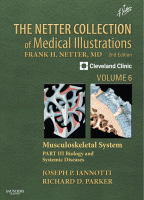Physical Address
304 North Cardinal St.
Dorchester Center, MA 02124

Septic Joint Septic Bursitis The human body contains more than 150 bursae, which are sacs or potential spaces lined with a synovial membrane and containing synovial fluid. Bursae, located in the subcutaneous tissue over bony prominences, permit virtually friction-free movement…

Injury to Soft Tissue Three basic mechanisms cause soft tissue injuries: blunt trauma, crushing injury, and penetrating trauma. Blunt and crushing injuries are called closed injuries because they do not penetrate the overlying skin. Penetrating (open) injuries violate the protective…

Initial Evaluation and Staging of Musculoskeletal Tumors An understanding of the tumors of the musculoskeletal system requires a thorough knowledge of clinical presentation, natural history, staging characteristics, histopathology, and response to treatment of these tumors. Common bone tumors include myeloma,…

Rheumatic Diseases The term rheumatic disease refers to any illness characterized by pain and stiffness in or around the joints. These diseases are divided into two main groups: disorders that involve the joints primarily (the different forms of arthritis) and…

Dwarfism—Overview and Achondroplasia Classification Although hereditary disorders of the skeleton are relatively rare, they attract a great deal of interest. Many of these disorders are associated with short stature, or dwarfism. Dwarfism can be either proportionate or disproportionate. Symmetric shortness…

Parathyroid Hormone The parathyroid gland regulates the calcium in the extracellular fluid by sensing small changes in calcium levels and rapidly modifying the secretion of parathyroid hormone (PTH). With a fall in the calcium level, PTH secretion is increased and,…

Structural Organization of Skeletal Muscle The principal function of skeletal muscles is to move the limbs, trunk, head, respiratory apparatus, and eyes. Most skeletal muscles are under voluntary control. They are composed of long multinucleated cells called muscle fibers, which…

Development of Musculoskeletal System Evolution The development of the human musculoskeletal system is an interesting demonstration of ontogeny recapitulating phylogeny. The genetic code that guides the continually changing body plan of the developing human results in a résumé of body…
Bones of the Hand Metacarpal Bones Five metacarpals form the skeleton of the hand. They are miniature “long” bones, comprising a shaft, a head, and a base. They are palpable on the dorsum of the hand and terminate distally in…
Bones and Joints of Forearm and Wrist Distal Parts of Radius and Ulna The distal end of the radius is broadened because its carpal articular surface is the bony contact of the forearm with the wrist and hand. This surface…